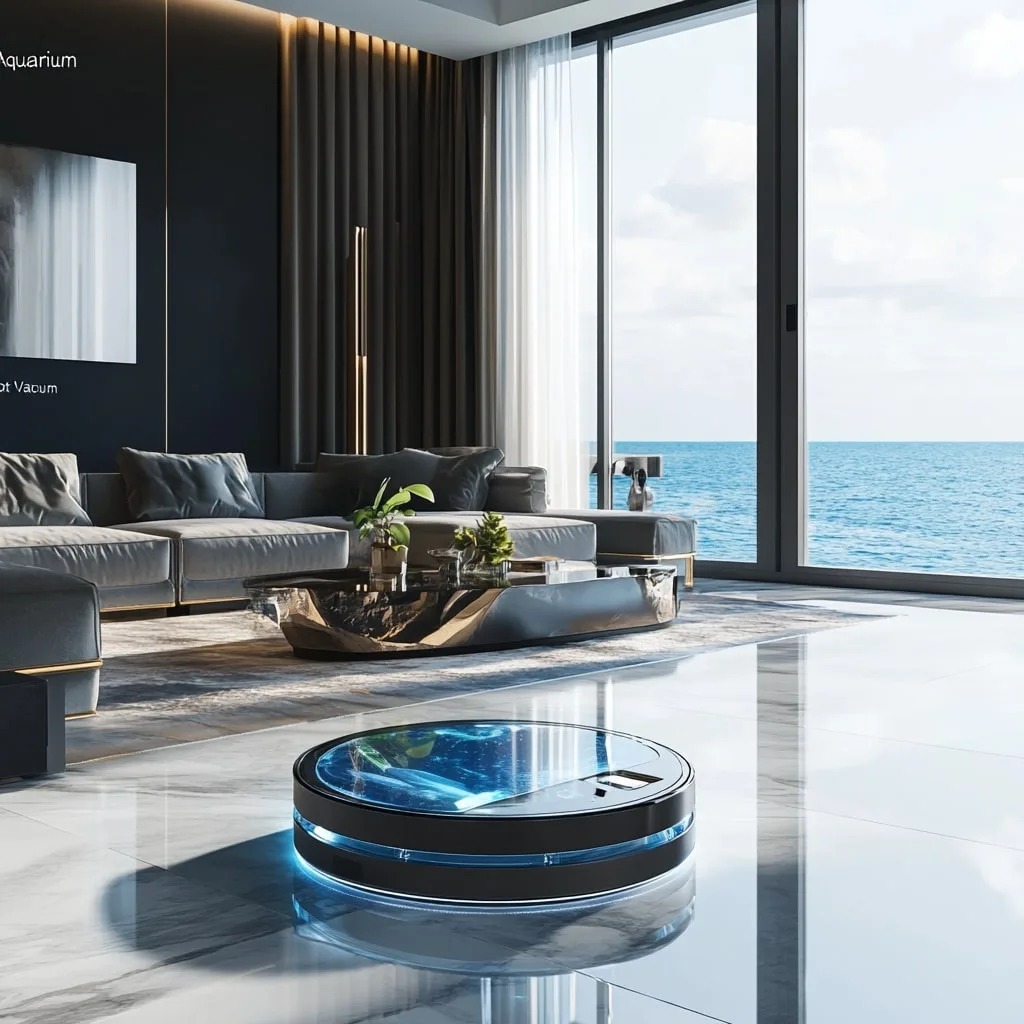Maintaining a clean aquarium has always been a balancing act—removing debris and waste without disturbing your aquatic ecosystem. Traditional methods involving siphons and manual vacuums get the job done but require significant time and effort. Enter the aquarium robot vacuum, an innovative solution that’s changing how fish enthusiasts approach tank maintenance.
These compact underwater robots represent the intersection of aquarium care and modern technology, offering autonomous cleaning that works with minimal intervention. For busy aquarists or those with mobility issues, these devices provide a way to maintain water quality without the physical demands of traditional cleaning methods.
In this comprehensive guide, we’ll explore how aquarium robot vacuums work, their benefits and limitations, top models on the market, and how to integrate one into your aquarium maintenance routine.
What Is an Aquarium Robot Vacuum?

The Basics of Automated Tank Cleaning
An aquarium robot vacuum is a self-contained device designed to navigate the bottom of fish tanks, automatically removing debris, uneaten food, and waste without human intervention. Think of it as a Roomba for your aquarium—a purpose-built cleaning assistant that works while you attend to other tasks.
These devices typically feature:
- Rechargeable batteries for cordless operation
- Smart navigation systems to avoid obstacles and decorations
- Gentle suction mechanisms that capture debris without harming fish
- Collection chambers for waste storage
- Filtration components to return clean water to the tank
How Aquarium Robot Vacuums Differ from Traditional Cleaning Tools
Unlike manual siphons that require constant attention, an aquarium robot vacuum operates independently. Traditional cleaning methods involve:
- Preparing collection buckets
- Positioning and controlling siphon tubes
- Carefully vacuuming substrate while avoiding fish
- Disposing of water and refilling the tank
In contrast, robot vacuums eliminate most of these steps, collecting debris in self-contained units while leaving water levels intact. This reduces stress on fish and simplifies the maintenance process dramatically.
The Technology Behind Aquarium Robot Vacuums

Navigation Systems and AI Integration
Modern aquarium robot vacuums incorporate sophisticated technologies that allow them to clean efficiently:
- Obstacle detection sensors help the units navigate around rocks, plants, and decorations
- Some premium models use AI-driven path planning for systematic cleaning
- Boundary recognition prevents vacuums from attempting to climb tank walls
- Smart technology allows some units to “learn” your tank’s layout over time
Suction Power and Filtration Mechanisms
Effective cleaning without disturbing the tank environment requires careful engineering:
- Adjustable suction strength allows for cleaning various substrate types
- Multi-stage filtration in some models captures particles of different sizes
- Specialized brushes help dislodge stubborn debris before suction
- Gentle intake designs ensure small fish and invertebrates aren’t accidentally collected
Benefits of Using an Aquarium Robot Vacuum
Time-Saving Automation for Busy Aquarists
The most obvious advantage of an aquarium robot vacuum is the time it saves:
- Reduced manual cleaning frequency from weekly to monthly in many cases
- “Set and forget” operation allows cleaning while you’re away
- Less physical effort particularly beneficial for larger tanks
- Consistent maintenance helps prevent major cleanup operations
Improved Water Quality and Fish Health
Beyond convenience, these devices contribute to better aquarium conditions:
- Continuous removal of waste prevents toxin buildup
- Reduced nitrate accumulation from decaying organic matter
- Fewer water changes needed when debris is consistently removed
- Decreased algae growth due to reduced nutrient availability
- Healthier fish due to improved water quality
Reduced Stress for Fish and Aquarists Alike
Traditional cleaning methods can disturb aquatic life:
- Robot vacuums operate gently without causing panic among fish
- No large water changes means stable water parameters
- Less human intervention reduces stress on shy species
- Peace of mind for aquarists concerned about tank maintenance while traveling
Choosing the Right Aquarium Robot Vacuum

Key Features to Consider
When selecting an aquarium robot vacuum, evaluate these important factors:
Tank Compatibility
- Size range compatibility with your aquarium dimensions
- Freshwater vs. saltwater functionality
- Substrate type suitability (sand, gravel, or bare bottom)
- Minimum water depth requirements
Battery Life and Charging
- Runtime per charge (typically 1-3 hours)
- Charging method (some require removal, others charge in-tank)
- Battery type and longevity expectations
- Quick-charge capabilities of certain models
Smart Features and Controls
- Remote control options via app or physical remote
- Programmable schedules for regular maintenance
- Status indicators for maintenance needs
- Integration with smart home systems in premium models
Top Aquarium Robot Vacuum Models
While specific recommendations change as technology evolves, these categories represent the current market:
Budget-Friendly Options
Entry-level aquarium robot vacuums ($50-150) provide basic functionality:
- Simple navigation paths
- Limited runtime (30-60 minutes)
- Manual charging
- Good for smaller tanks
Mid-Range Solutions
Mid-tier models ($150-300) offer enhanced capabilities:
- Smart navigation
- Extended runtime (1-2 hours)
- App control options
- Suitable for most home aquariums
Premium Aquarium Cleaning Systems
High-end systems ($300+) feature advanced technology:
- AI-driven cleaning patterns
- Multiple cleaning modes
- Extended warranties
- Compatible with large or complex setups
Installation and Operation Tips

Setting Up Your Aquarium Robot Vacuum
Proper setup ensures your aquarium robot vacuum functions optimally:
- Charge fully before first use
- Read the manual thoroughly—each model has specific requirements
- Remove especially delicate decorations if recommended
- Consider substrate depth—some models require certain minimum depths
- Test in a small area before full deployment
Maintenance Schedule for Your Robot Vacuum
Like any equipment, these devices require care:
- Empty collection chambers after each cleaning cycle
- Rinse filter components as recommended (typically weekly)
- Check brushes and wheels for tangled debris or plant matter
- Clean sensors to maintain navigation accuracy
- Replace batteries and worn components according to manufacturer guidelines
Common Concerns and Limitations
Will an Aquarium Robot Vacuum Harm My Fish or Plants?
This is a top concern for potential buyers:
- Most models feature fish-safe designs with protected intakes
- Very small fish or fry might still be at risk with some models
- Delicate plants might be uprooted by certain robot types
- Research specific models for compatibility with your aquarium inhabitants
Understanding the Limitations
Aquarium robot vacuums aren’t perfect solutions for all situations:
- Cannot replace water changes entirely
- May struggle with vertical surfaces or fine debris
- Some models have difficulty with specialized substrates like very fine sand
- Initial cost can be higher than traditional cleaning tools
Integration with Overall Aquarium Maintenance

Creating a Comprehensive Cleaning Strategy
An aquarium robot vacuum works best as part of a complete maintenance approach:
- Use the robot for routine debris removal
- Schedule periodic deep cleanings for areas the robot can’t reach
- Maintain regular water testing to monitor parameter stability
- Adjust feeding amounts to reduce waste accumulation
- Consider complementary technologies like UV sterilizers or protein skimmers
Monitoring Effectiveness and Adjusting
Track how well your robot vacuum performs:
- Note any recurring problem areas in your tank
- Adjust cleaning frequency based on debris accumulation
- Monitor water quality parameters to gauge effectiveness
- Consider seasonal adjustments as fish activity and feeding change
Environmental and Energy Considerations

Energy Efficiency of Aquarium Robot Vacuums
The environmental impact of these devices is relatively minimal:
- Low power consumption compared to many aquarium components
- Reduced water waste from fewer water changes
- Energy-efficient models use as little as 5-10 watts during operation
- Solar charging options available for some outdoor pond models
Sustainability Factors
Consider these aspects when purchasing:
- Product longevity and repairability
- Manufacturer’s recycling programs for batteries and components
- Energy Star certifications on charging systems
- Reduced chemical usage due to improved water quality
User Experiences and Case Studies
Success Stories from Long-Term Users
Many aquarists report significant benefits after adopting aquarium robot vacuums:
- Dramatic reduction in manual cleaning time
- Improved clarity in previously problematic tanks
- Successfully maintaining larger tanks with less effort
- Particular benefits for elderly or disabled fish keepers
Professional Aquarium Maintenance Perspectives
Commercial operations have embraced these technologies:
- Public aquariums use industrial versions for large exhibits
- Maintenance services incorporate robots into their regular care packages
- Breeding operations benefit from consistent waste removal
- Retail stores showcase these devices in display tanks
Future Trends in Aquarium Robot Vacuum Technology

Emerging Innovations
The next generation of aquarium robot vacuums promises exciting advances:
- AI-enhanced navigation with improved obstacle avoidance
- Water quality sensors integrated into cleaning units
- Multi-function robots that clean glass and substrate
- Advanced app integration for detailed cleaning reports
- Specialized models for specific tank types (reef, planted, etc.)
Integration with Smart Aquarium Systems
The future lies in connected ecosystems:
- Automated cleaning based on water parameter readings
- Coordination with feeding systems to clean after meals
- Data collection for long-term aquarium health monitoring
- Voice control through smart home hubs
Is an Aquarium Robot Vacuum Right for You?
The aquarium robot vacuum represents a significant step forward in fishkeeping technology, offering convenience, improved water quality, and reduced maintenance stress. While these devices can’t completely replace traditional maintenance practices, they provide valuable assistance that makes the hobby more accessible and enjoyable.
When considering whether to invest in one of these innovative cleaning assistants, evaluate your specific needs:
- Tank size and configuration
- Types of fish and plants you keep
- Your maintenance schedule and challenges
- Budget constraints
For many aquarists, especially those with larger tanks or limited time, an aquarium robot vacuum offers a return on investment through improved water quality, healthier fish, and more enjoyable fishkeeping. As technology continues to advance, these devices will likely become standard equipment in many home aquariums, just as automated tools have transformed other aspects of pet care.
Whether you’re a seasoned aquarist looking to simplify maintenance or a newcomer wanting to ensure success in the hobby, an aquarium robot vacuum might be the solution that helps you maintain a thriving underwater world with less effort.
Ready to take the plunge into automated aquarium maintenance? Research the models that best fit your specific setup, and you might find yourself wondering how you ever managed without this helpful underwater assistant.

